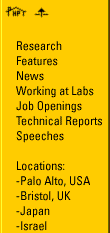| |
HP Labs Technical Reports
Click here for full text:


Machine-Description Driven Compilers for EPIC Processors
Rau, Bantwal Ramakrishna; Kathail, Vinod; Aditya, Shail
HPL-98-40
Keyword(s): retargetable compilers; table-driven compilers; machine description; processor description; instruction-level parallelism; EPIC processors; VLIW processors; EPIC compilers; VLIW compilers; code generation; scheduling; register allocation
Abstract: In the past, due to the restricted gate count available on an inexpensive chip, embedded DSPs have had limited parallelism, few registers and irregular, incomplete interconnectivity. More recently, with increasing levels of integration, embedded VLIW processors have started to appear. Such processors typically have higher levels of instruction-level parallelism, more registers, and a relatively regular interconnect between the registers and the functional units. The central challenges faced by a code generator for an EPIC (Explicitly Parallel Instruction Computing) or VLIW processor are quite different from those for the earlier DSPs and, consequently, so is the structure of a code generator that is designed to be easily retargetable. In this report, we explain the nature of the challenges faced by an EPIC or VLIW compiler and present a strategy for performing code generation in an incremental fashion that is best suited to generating high-quality code efficiently. We also describe the Operation Binding Lattice, a formal model for incrementally binding the opcodes and register assignments in an EPIC code generator. As we show, this reflects the phase structure of the EPIC code generator. It also defines the structure of the machine-description database, which is queried by the code generator for the information that it needs about the target processor. Lastly, we discuss general features of our implementation of these ideas and techniques in Elcor, our EPIC compiler research infrastructure.
00 Pages
Back to Index
|




